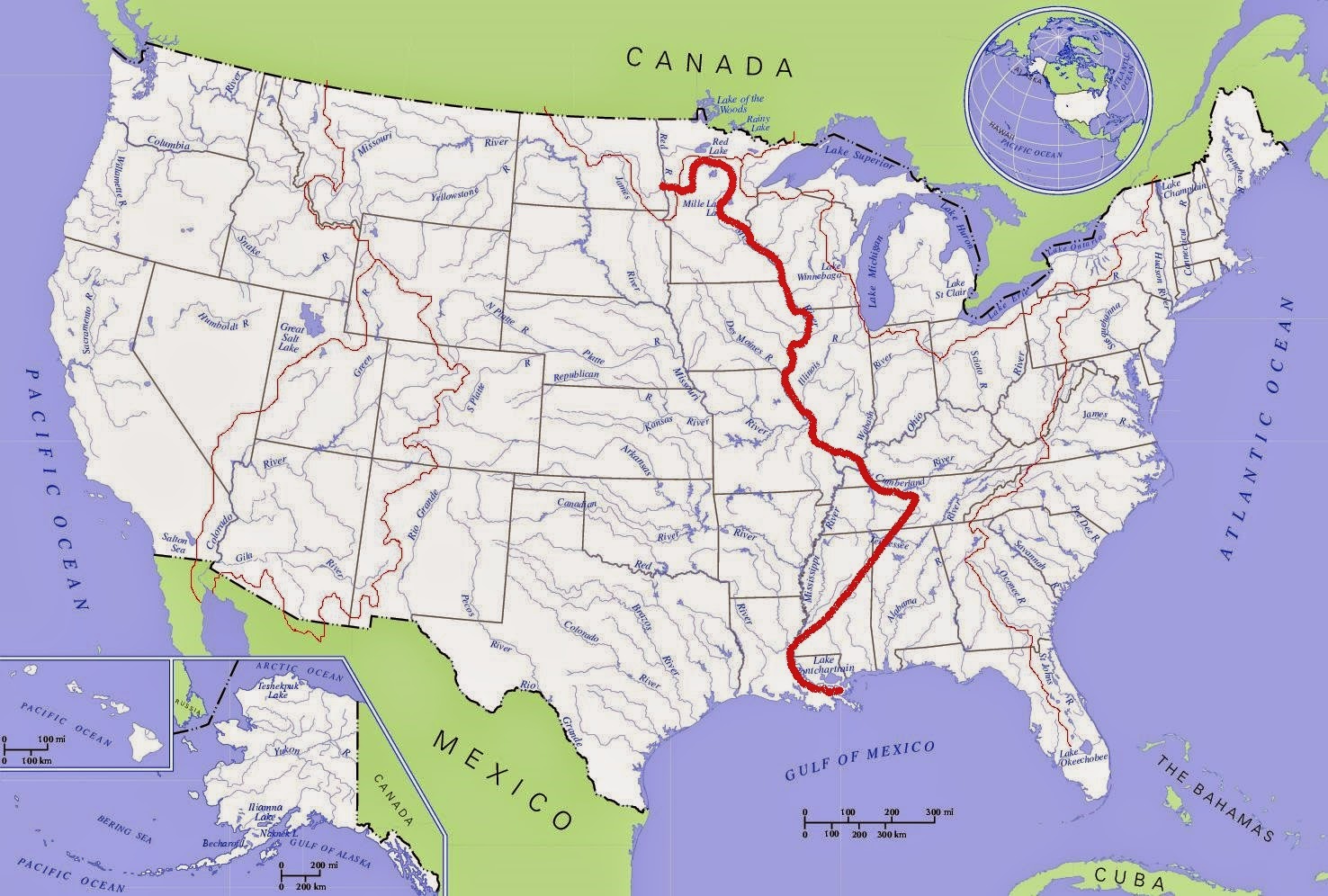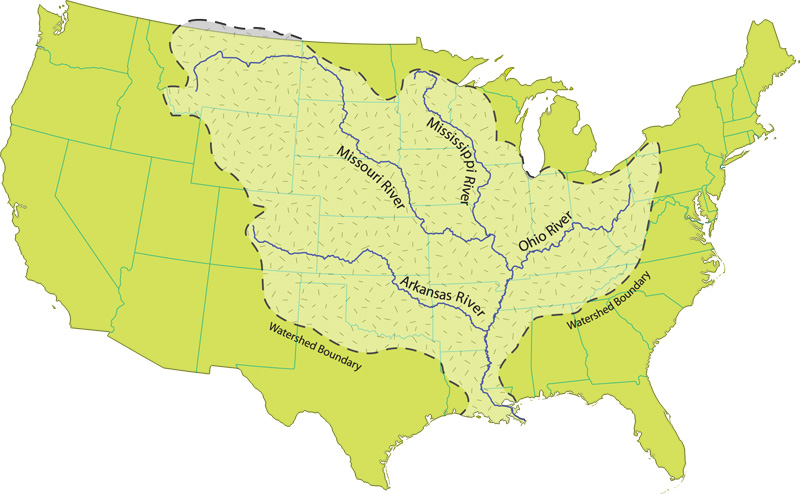![]()
Los Grandes Lagos en USA y su Alarmante Contaminación

Distrito de los Grandes Lagos y el Mississippi. Fuente:Mississippi River Trail 2013

Cuenca del Mississippi. Fuente Natural Forest Service
Recientemente he recibido numerosos mails de USDA Office of Communications, como alguno de los que os expongo al final de este post. De este modo se están implementando programas con vistas a paliar un gran impacto ambiental de difícil solución bajo los cánones actuales de la agricultura industrial. El problema causado por las aguas residuales y en especial a través de una escorrentía repleta de nutrientes procedentes de la sobrefertilización de los suelos agrícolas, pesticidas y aguas residuales mal tratadas, comienza a ser insostenible en términos ambientales, pero también de salud pública (por ejemplo las floraciones algales, aguas cuya carga de contaminantes supera los límites tolerables por la legislación en lo concerniente al agua potable). Si ponéis en vuestro motor de búsqueda (en este caso el controvertido Google) los palabros “Great lakes contamination agrochemicals” os saldrá un listado con más de más de cuatro millones y medio de ítems. Ahora se acusa a la extensión de la Labranza cero de aumentar la gravedad del problema aludido. Recordemos que la denominada agricultura sin labranza se basa en agroquímicos y transgénicos, sindo muy distinta de la denominada ecológica. Podéis leer por ejemplo esta página Web en la que se expone ampliamente el problema para el distrito de los grandes lagos. De aquí que la alarma ha saltado en USDA data la abundancia recibida de mails en menos de dos semanas. En este post no me reiteraré sobre lo que ya he abundado en demasiadas ocasiones. Tan solo mentar “once again” que nuestros sistemas de producción agraria industrial no funcionan, son insustentables a todas luces, y a las pruebas me remito, como cuando os hablaba de la que ya sufre el Golfo de México, inducida por la polución descontrolada de la cuenca del Mississippi. La tecnología agraria actual no pueda frenar tan pavorosa degradación ambiental y atentar contra la salud de los ciudadanos, por lo que hay que insistir en que, o se cambia el modelo actual o la gran cloaca americana seguirá creciendo, como en otros muchos numerosos países. Abajo os dejo alguna de las múltiples noticias recibidas.
Juan José Ibáñez
Don’t Just Blame Agriculture For The Latest Algae Bloom
Joanne JonesMarketing Specialist – American Farriers Journal & No-Till Farmer
Farmers are taking the heat for the Lake Erie algae bloom that prompted a water ban in Toledo, Ohio, just over a week ago.
On Aug. 2, nearly half a million residents in northwest Ohio were told not to drink or use the water, after two sample readings from a local water treatment plant tested above the “Do Not Drink” recommended 1 microgram per liter standard for microcystin. Microcystin is a bacteria released from algae blooms that can cause liver damage in humans and kill pets and wildlife. The ban was lifted 2 days later.
While the scare has rightfully served as a wake-up call for the algae problems the western basin of Lake Erie has been facing in recent years, it’s also caused a lot of finger pointing on who’s to blame — namely at farmers. Some experts are blaming no-till practices, saying they… continue reading here http://ow.ly/AhLLS
To receive this free, twice-a-month e-newsletter, sign up here http://ow.ly/AhLGf
From the Desk of Laura Allen: Don’t Just Blame Agriculture For The Latest Algae Bloom no-tillfarmer.com
Farmers are taking the heat for the Lake Erie algae bloom that prompted a water ban in Toledo, Ohio, just over a week ago. Don’t Just Blame AgricultureFor The Latest Algae Bloom – See more at: http://www.no-tillfarmer.com/pages/Spre/From-the-Desk-of-Laura-Allen-Dont-Just-Blame-Agriculture-For-The-Latest-Algae-Bloom-8-13-14.php#sthash.QTBVTVYa.dpuf
No se limite a Blame Agricultura Para la última Algas Bloom
Joanne Jones (Marketing Specialist – American Journal & Farriers cero labranza Farmer)
Los agricultores están llevando la peor parte de la floración de las algas del lago Erie que motivó la prohibición de agua en Toledo, Ohio, hace poco más de una semana. El 2 de agosto, se informó a cerca de medio millón de habitantes en el noroeste de Ohio no beber ni usar el agua, después de dos lecturas de la muestra a partir de una planta de tratamiento de agua local probado por encima de la «no beber» recomendada 1 microgramo por litro estándar para microcistina.
La microcistina es una bacteria liberados de la proliferación de algas que pueden causar daños en el hígado en los seres humanos y matar a los animales domésticos y la vida silvestre. La prohibición se levantó 2 días más tarde. Mientras que el susto ha servido con razón como una llamada de atención para los problemas de algas de la cuenca occidental del lago Erie se ha enfrentado en los últimos años, también ha causado una gran cantidad de dedo que señala en quién tiene la culpa – a saber, a los agricultores. Algunos expertos culpan a prácticas de labranza cero, diciendo que … seguir leyendo aquí http://ow.ly/AhLLS
FROM THE DESK OF LAURA ALLEN Don’t Just Blame AgricultureFor The Latest Algae Bloom August 13, 2014 Farmers are taking the heat for the Lake Erie algae bloom that prompted a water ban in Toledo, Ohio, just over a week ago. On Aug. 2, nearly half a million residents in northwest Ohio were told not to drink or use the water, after two sample readings from a local water treatment plant tested above the “Do Not Drink” recommended 1 microgram per liter standard for microcystin. – See more at: http://www.no-tillfarmer.com/pages/Spre/From-the-Desk-of-Laura-Allen-Dont-Just-Blame-Agriculture-For-The-Latest-Algae-Bloom-8-13-14.php#sthash.QTBVTVYa.dpuf
Microcystin is a bacteria released from algae blooms that can cause liver damage in humans and kill pets and wildlife. The ban was lifted 2 days later.
While the scare has rightfully served as a wake-up call for the algae problems the western basin of Lake Erie has been facing in recent years, it’s also caused a lot of finger pointing on who’s to blame — namely at farmers. Some experts are blaming no-till practices, saying they leave phosphorus more stratified near the soil surface and prone to runoff.
There’s no denying that phosphorus runoff does contribute to these algae blooms. And yes, some of that comes from agriculture. But an article from the science and technology magazine Wired says that with best-management practices, farms only lose an average of about 2% of applied fertilizer.
And what about golf courses, sewage treatment plants and other sources that discharge into waterways? At Lake Champlain, located along the border of New York and Vermont, it was discovered that about half of the lake’s phosphorus problem comes from developed land. Experts with Lake Champlain’s Lawn To Lake organization say one acre of urban/suburban land, “contributes about four times more phosphorus to the lake than one acre of farm land.”
It’s not to imply farmers shouldn’t do everything possible to reduce fertilizer runoff, whether it’s seeding cover crops to hold nutrients in place, only applying the amount of fertilizer needed to meet plant needs, or placing fertilizers in-furrow instead of broadcasting them.
Wired says the problem is volume — there is so much land in the Lake Erie watershed that is applied with fertilizer that even the small amounts that run off are still enough to cause problems.
But casting all blame on farmers is a mistake. Doing so not only hurts farmers, but the effort to protect our bodies of water as well. Agriculture isn’t the only industry that should be held responsible for the conditions that lead to algae blooms, and it probably isn’t the only industry that can fix it.
Let’s look a lLaura Allen,
Staff Writer
No-Till Farmer
lallen@lesspub.comittle deeper and do our best to find a well-rounded answer to the problem.
COMMENTS: 1
Explain the blue green algae
Posted from: Travis Martin, 8/13/14 at 4:20 PM CDT
Is it possible to have a good explanation on what is the Blue Green Algae? (Webinar, article, speaker at the annual conference…) It is a problem, I got to see it in Big Creek Lake in Iowa for the first time two weeks ago. It is an «Erie» site. I would like to understand this problem before any fingers get pointed at anyone. I would not want to drink the stuff and stuff like this shouldn’t be happening in the United States. Let’s understand it then fix it.

[…] Los Grandes Lagos en USA y su Alarmante Contaminación […]